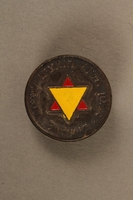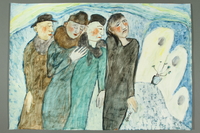Overview
- Brief Narrative
- Grayscale painting created by Dina Pollak Gabos in 1977, commemorating her family’s escape from Yugoslavia to Italy in December 1941. The Axis powers invaded Yugoslavia on April 6, 1941. Dina, age three, and her parents Otto and Rifka lived in Zagreb, which became part of Croatia and was ruled by the fascist anti-Semitic Ustasa regime. On April 28, Otto was sent by the Ustasa police to Kerestinec concentration camp, but was released in June. In October, the family fled to Italian controlled Ljubljana. They lived in hiding until they escaped to Italy in December 1941. The family lived as confined refugees in Valdobiadenne, Italy, from January 1942 until September 1943, when Italy was occupied by Germany after the Italians surrendered to the Allies. The Pollak family acquired false papers and fled to southern Italy. They were freed in July 1944, then lived in Santa Croce displaced persons camp in Bari. Rifka’s mother, eight siblings, and their families were all murdered in Croatia during the war. In 1950, Dina and her parents emigrated to New York.
- Artwork Title
- Family escapes Yugoslavia in 1941
- Date
-
commemoration:
1941 December
creation: 1977
- Geography
-
creation:
United States
- Credit Line
- United States Holocaust Memorial Museum Collection, Gift of Dina Pollak Gabos
- Markings
- back, repeating diamond pattern, preprinted, brown ink : LEONARDESCA
- Signature
- back, handwritten, marker : GABOS / 1977
- Contributor
-
Artist:
Dina Gabos
Subject: Dina Gabos
- Biography
-
Dina Pollak was born on January 11, 1938, in Zagreb, Yugoslavia [Croatia], to Otto and Rifka Musafia Pollak. Otto was born on January 21, 1899, in Zagreb, to Samuel and Johanna Schneid Pollak. Rifka was born on December 1, 1906, in Bijeljina, Yugoslavia, to Meir and Sara Elazar Musafia. Rifka had eight siblings: Blanka, Isak, Rachela, Johanna, Solci, Efraim, Menashem, and Salamon. Otto was a lawyer and an active Zionist. Rifka was a language teacher and seamstress. The family was Jewish and lived in Zagreb.
On April 6, 1941, the Axis powers, Germany, Italy, Hungary, and Bulgaria invaded Yugoslavia and divided it amongst themselves. The Pollak and Musafia families lived in the newly created Independent State of Croatia, controlled by the Ustasa government, which enacted policies to persecute Jews and terrorized the country with the mass slaughter and expulsion of the Serbs. On April 28, 1941, Otto was arrested in Zagreb by the Ustasa police and sent to Kerestinec concentration camp. In June 1941, he was sent back to Zagreb and confined there. Rifka and Dina were in Split at the time. The Ustasa regime issued a travel permit for Rifka and her child, valid for travel from Split to Zagreb from July 4, 1941 to August 4, 1941. In October, Otto, Rifka, and Dina fled Zagreb for Italian occupied Ljubljana, Yugoslavia [Slovenia]. They lived in hiding from October until December 1941, when they escaped to Italy. From January 1942 until September 1943, they lived as confined refugees in Valdobiaddene, Treviso Province. In July 1943, the Allies landed in Sicily and Mussolini was deposed. On September 3, the Italian government reached an armistice with the Allies. The Pollak family obtained false papers and made their way to southern Italy as Ottone, Ria, and Dina Pollan, hiding from the occupying German troops. The region they were living in liberated in July 1944, as Allied forces advanced north of Rome. After liberation, they lived in Bari, Italy, in the Santa Croce displaced persons camp.
On April 11, 1950, the family boarded the US Navy ship General J H McRae in Bremerhaven, Germany. They arrived in New York on April 24, 1950, and settled in New York City. They learned that Rifka’s mother and siblings were all killed during the war. Rachela and her husband Salamon Alkalaj were deported from Bijeljina and killed in 1941. Their son, Mosho, was shot in Bijeljina for fighting Nazis. Sara and Johanna were sent to Djakovo concentration camp, where Sara was killed and Johanna died of typhus in 1942. Johanna’s husband, Menachem Albahari, had been killed in Jadovno concentration camp in 1941. Solci was deported from Brno, in German occupied Czechoslovakia and killed in Treblinka. Solci's husband Hugo Pollak was killed in Brno. Rifka’s remaining siblings and their families were all deported and killed. Rifka and Otto became naturalized American citizens on June 13, 1955, and Dina did also on February 27, 1956, shortly after her eighteenth birthday. Dina became an artist and married Andre Gabos. Otto, age 83, died on January 22, 1982. Rifka, age 87, died on August 11, 1994.
Physical Details
- Classification
-
Art
- Category
-
Paintings
- Object Type
-
Portraits, Group (lcsh)
- Physical Description
- Acrylic painting in a naive style and grayscale tones on canvas board depicting a young girl and her parents standing on a gray path in the middle of a flat featureless landscape with a gray sky. The 3 figures are painted flat, without perspective, and have similar features: dark eyes, pale faces with neutral expressions, and arms held stiffly at their sides. A young girl with straight black hair stands on the path to the left, apart from her parents but angled toward them. Her parents stand next to each other in the center of the path, with the father angled left towards his wife. The mother has short brown hair and light red lips. The father has gray hair and black glasses. All are clothed in black, gray, and brown outfits with hats and coats. The figures stand upon a panel of three paths, light gray flanked by brownish gray, meant to appear as if they are extending endlessly into the distance. The artist's signature and date are inscribed on the back. The manufacturer name and logo are printed on the back.
- Dimensions
- overall: Height: 11.875 inches (30.163 cm) | Width: 19.500 inches (49.53 cm) | Depth: 0.125 inches (0.318 cm)
- Materials
- overall : canvas board, acrylic paint, ink
Rights & Restrictions
- Conditions on Access
- No restrictions on access
- Conditions on Use
- No restrictions on use
Keywords & Subjects
- Topical Term
- Autobiographical memory in art--Pictorial works. Hidden children (Holocaust)--Italy--Biography. Holocaust, Jewish (1939-1945)--Yugoslavia--Personal narratives. Holocaust, Jewish (1939-1945), in art--Pictorial works. Jewish children in the Holocaust--Croatia--Biography. Jewish refugees--Italy--Biography. World War, 1939-1945--Refugees--Italy--Personal narratives.
Administrative Notes
- Legal Status
- Permanent Collection
- Provenance
- The painting was donated to the United States Holocaust Memorial Museum in 2012 by Dina Pollak Gabos.
- Funding Note
- The cataloging of this artifact has been supported by a grant from the Conference on Jewish Material Claims Against Germany.
- Record last modified:
- 2023-02-23 16:44:41
- This page:
- https://collections.ushmm.org/search/catalog/irn78323
Download & Licensing
In-Person Research
- By Appointment
- Request 21 Days in Advance of Visit
- Plan a Research Visit
- Request to See This Object
Contact Us
Also in Dina Pollak Gabos collection
The collection consists of a contemporary painting and photographs relating to the experiences of Dina Pollak Gabos, and her parents Otto and Rifka Pollak, who escaped Yugoslavia in 1941 and lived in hiding in Italy until 1944. Accretion: Painting: by Dina Gabos (donor); acrylic on paper; titled: “Sorrow”; dated: 1982; 28x19.5”; Calendar: issued by Jewish National Fund (Keren Kayemet L’Israel) for the Hebrew year 5710 (1949-1950); with images of symbols of the State of Israel; map of the State of Israel and a list of new settlements founded by JNF in Israel. In Italian; Membership ID: issued by The Zionist Organization in the South of Italy to Rifka Pollak, donor’s mother; dated” July 1, 1945 in Hebrew and English; Photographs: depicting a group of Jewish Holocaust survivors posing with the sign “HIAS of America” on their way to Palestine; dated: 1945; Bari, Italy and a makeshift synagogue in Bari, Italy in 1945; Invitation: to luncheon for State of Israel Bonds and meeting the Foreign Minister of the State of Israel, Golda Meir; dated: December 9, 1956; New York City, US; Pin: with two enamel triangles, red and yellow, forming a Star of David; with a Hebrew inscription: “Association of Former Prisoners of Nazis in Israel” Some of these materials may be combined into a single collection in the future.
Date: approximately 1930-1977

Pin
Object
Dina Gabos papers
Document
Documents: permit to travel issued to Rifka Pollak and her child by the Ustaša regime in Croatia in July 1941; telegram sent by Golda Myerson (Meir) to the Association of Yugoslav Jews in US in May 1948 asking for funds to bring surviving Jews of Europe to Israel; Photographs: Rifka and Otto Pollak (donor’s parents); studio photograph of Dina dedicated to her aunt Blanka, dated May 6, 1940; portrait of Johana and Isak Albahari (donor’s maternal aunt and her husband) who were murdered in Djakovo camp in Croatia in 1942; copy of painting by Dina Gabos depicting herself and her parents on the run in Italy during the Holocaust
Dina Pollak Gabos photographs
Document
Five studio photographs depicting siblings of Rifka Musafia Pollak; Efraim, Solci, Rahela and Menashe.
Dina Pollak Gabos papers
Document
Calendar: issued by Jewish National Fund (Keren Kayemet L’Israel) for the Hebrew year 5710 (1949-1950); with images of symbols of the State of Israel; map of the State of Israel and a list of new settlements founded by JNF in Israel. In Italian; Membership ID: issued by The Zionist Organization in the South of Italy to Rifka Pollak, donor’s mother; dated” July 1, 1945 in Hebrew and English; Photographs: depicting a group of Jewish Holocaust survivors posing with the sign “HIAS of America” on their way to Palestine; dated: 1945; Bari, Italy and a makeshift synagogue in Bari, Italy in 1945; Invitation: to luncheon for State of Israel Bonds and meeting the Foreign Minister of the State of Israel, Golda Meir; dated: December 9, 1956; New York City, US




